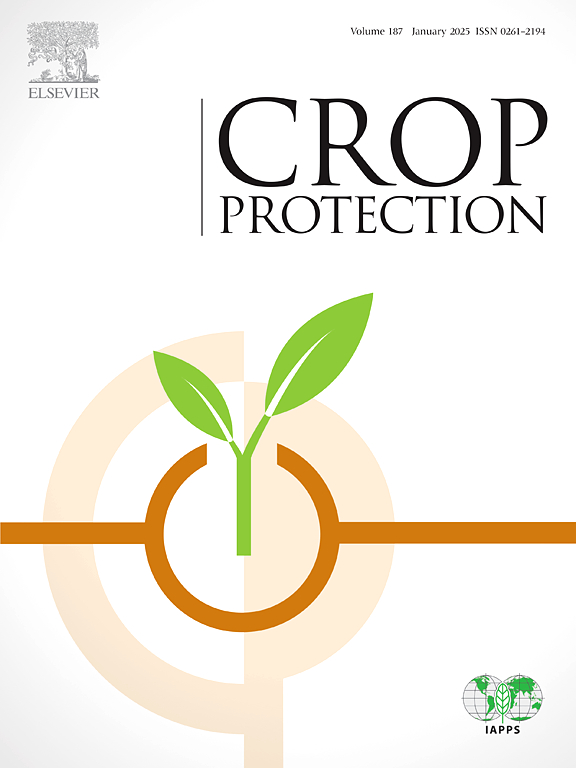文章标题基耶大蒜(Allium sativum L)种植区的灰茎属植物初报
IF 2.5
2区 农林科学
Q1 AGRONOMY
引用次数: 0
摘要
大蒜(Allium sativum L.)是苋菜科的重要植物,在世界范围内广泛种植。大蒜的产量和品质由于害虫和真菌的影响而下降。在2020-2022年3月至4月期间,在加齐安泰普(阿拉伯和Oğuzeli区)和kahramanmaraku(纳尔伊区)大蒜种植区进行的调查研究中,我们观察到白色斑点,然后是深绿色到黑色的孢子床。到5月底,在严重感染的地区,大蒜植株发生了黄变和死亡。从15个不同的大蒜田采集有症状的叶片样本进行病原菌分离,发病率在90%左右。对39株分离株的致病性、形态和系统发育进行了研究。基于内部转录间隔段(ITS)、RNA聚合酶II亚基β (RPB2)和甘油醛-3-磷酸脱氢酶(GAPDH)区域的形态特征和系统发育分析,鉴定了两株分离株为大蒜病原菌S. eturmium,这是一种在世界范围内造成严重产量损失的重要病原体。这是首次报道产自本文章由计算机程序翻译,如有差异,请以英文原文为准。
First report of Stempylium eturmiunum from garlic (Allium sativum L) growing areas of Türkiye
Garlic (Allium sativum L.) is an important species of the Amaryllidaceae family and is widely cultivated worldwide. The yield and quality of garlic production decrease due to pests and fungal agents. Survey studies conducted in Gaziantep (Araban and Oğuzeli districts) and Kahramanmaraş (Narlı district) garlic-growing areas between March and April 2020–2022 we observed white spots followed by dark green to black spore beds. Toward the end of May, yellowing and death of garlic plants occurred in severely infected fields. Symptomatic leaf samples were collected from 15 different garlic fields for pathogen isolation, with disease incidence around 90 %. A total of 39 Stemphylium spp. isolates were recovered, and their pathogenicity, morphology, and phylogeny were investigated. Based on morphological characteristics and phylogenetic analysis of the internal transcribed spacer (ITS), RNA polymerase II subunit beta (RPB2), and glyceraldehyde-3-phosphate dehydrogenase (GAPDH) regions, two isolates were identified as S. eturmiunum, a significant garlic pathogen causing serious yield losses worldwide. This is the first report of S. eturmiunum infecting garlic from Türkiye.
求助全文
通过发布文献求助,成功后即可免费获取论文全文。
去求助
来源期刊

Crop Protection
农林科学-农艺学
CiteScore
6.10
自引率
3.60%
发文量
200
审稿时长
29 days
期刊介绍:
The Editors of Crop Protection especially welcome papers describing an interdisciplinary approach showing how different control strategies can be integrated into practical pest management programs, covering high and low input agricultural systems worldwide. Crop Protection particularly emphasizes the practical aspects of control in the field and for protected crops, and includes work which may lead in the near future to more effective control. The journal does not duplicate the many existing excellent biological science journals, which deal mainly with the more fundamental aspects of plant pathology, applied zoology and weed science. Crop Protection covers all practical aspects of pest, disease and weed control, including the following topics:
-Abiotic damage-
Agronomic control methods-
Assessment of pest and disease damage-
Molecular methods for the detection and assessment of pests and diseases-
Biological control-
Biorational pesticides-
Control of animal pests of world crops-
Control of diseases of crop plants caused by microorganisms-
Control of weeds and integrated management-
Economic considerations-
Effects of plant growth regulators-
Environmental benefits of reduced pesticide use-
Environmental effects of pesticides-
Epidemiology of pests and diseases in relation to control-
GM Crops, and genetic engineering applications-
Importance and control of postharvest crop losses-
Integrated control-
Interrelationships and compatibility among different control strategies-
Invasive species as they relate to implications for crop protection-
Pesticide application methods-
Pest management-
Phytobiomes for pest and disease control-
Resistance management-
Sampling and monitoring schemes for diseases, nematodes, pests and weeds.
 求助内容:
求助内容: 应助结果提醒方式:
应助结果提醒方式:


